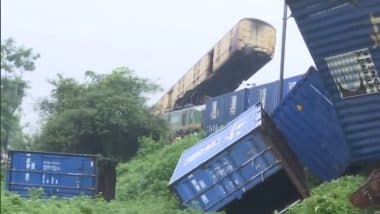Mumbai, June 17: In the wake of the tragic railway collision near New Jalpaiguri station in West Bengal's Darjeeling, where a goods train rammed into the Sealdah-bound Kanchanjungha Express, has highlighted concerns about railway safety systems. The collision on the morning of June 17 tragically claimed eight lives and left 30 passengers injured, with three compartments of the Kanchanjungha Express derailing as a result. Reports indicate that the railway tracks at the accident site were not equipped with the Kavach system.
The Kavach system, introduced to enhance railway safety, gained renewed attention following the Darjeeling accident, reminiscent of the Balasore train tragedy last year, which claimed the lives of 288 passengers. The absence of the Kavach system at the site of this tragic accident has raised questions about railway safety protocols and their implementation. Understanding the Kavach system sheds light on its role in preventing accidents. Kanchanjungha Express Train Accident: Goods Train Driver Disregarded Signal, Says Railway Board Chairperson Jaya Varma Sinha (Watch Videos).
What is Kavach System?
The Kavach system is an advanced safety mechanism implemented by Indian Railways to enhance the safety of train operations, particularly to prevent collisions. Primarily, Kavach employs a combination of GPS (Global Positioning System) and radio communication technologies to track train movements in real time. It continuously monitors the speed and location of trains, comparing this data with predefined safety parameters. If a train exceeds these parameters or encounters a potential collision risk, the Kavach system automatically triggers emergency brakes, thereby preventing accidents. West Bengal Train Accident Update: Five Dead, Dozens Injured as Goods Train Rams Into Sealdah-Bound Kanchanjungha Express (Watch Video).
It functions as an Automatic Train Protection (ATP) system designed to mitigate the risks associated with human error and operational oversights.
Why Was Kavach System Absent at West Bengal Accident Site
The absence of the Kavach system at the site of the Darjeeling accident can be attributed to the ongoing implementation and deployment process across the vast Indian Railways network. Despite significant progress in tendering and deployment, Kavach has not yet been installed on all railway routes across the country. Indian Railways has issued tenders for a substantial portion of the system, covering approximately 6,000 kilometres, but these efforts are ongoing and have not yet encompassed all critical routes.
However, the Darjeeling region, specifically the tracks near New Jalpaiguri station where the accident occurred, did not have Kavach installed. Railway officials have cited various reasons for this, including the prioritisation of high-traffic and critical routes for initial deployment, logistical challenges, and the phased rollout strategy across different railway zones. Efforts are underway to expand the number of approved Original Equipment Manufacturers (OEMs) for Kavach to enhance capacity and accelerate the implementation process.
(The above story first appeared on LatestLY on Jun 17, 2024 03:30 PM IST. For more news and updates on politics, world, sports, entertainment and lifestyle, log on to our website latestly.com).













 Quickly
Quickly





















